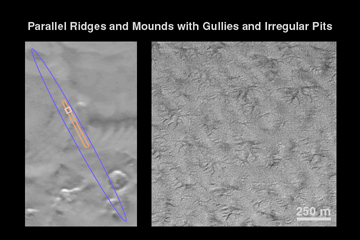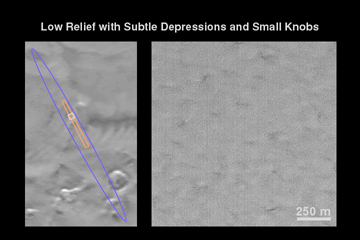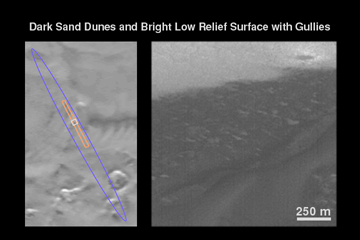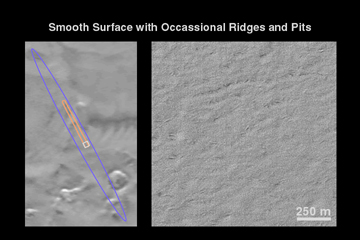
|
MOC2-191a
Parallel Ridges with Rough Texture and Residual Frost
This picture shows a set of parallel ridges trending from upper left to
lower right, spaced about 250-500 meters (273-547 yards)
from one another. The amplitude
of these ridges is not known, but elsewhere they are less than 20 m
(66 ft) high. The surface also has irregular, light-toned knobs that
resemble large boulders or pinnacles.
|

|
MOC2-191b
Parallel Ridges and Mounds with Gullies and Irregular Pits
A large portion of the landing ellipse (and the majority of the area
seen in this image) is covered by parallel ridges surmounted by
isolated groups of gullies and pits. The gully systems typically
extend less than 500 meters (547 yards), and are often only a few
hundred meters across. These gullies do not show the integration
normal for fluid erosion (i.e., they were not carved by running
water); instead, they have the form of cracks and depressions expanded
by wall- and head-enlargement by processes such as sapping (removal of
wall support by fluid seepage or the evaporation of ground ice) or
ablation (removal of ices by sublimation and wind).
|

|
MOC2-191c
Low Relief with Subtle Depressions and Small Knobs
Some areas show little or no topographic relief (i.e., the area
is relatively flat with no hills, ridges, or gullies).
One class of this type of surface displays small, subtle,
isolated depressions and
areas of the rough texture made up of light-toned patches of
knobs that resemble large boulders or pinnacles.
|

|
MOC2-191d
Dark Sand Dunes and Bright Low Relief Surface with Gullies
The darkest surface in the landing ellipse, now seen without its
seasonal bright frost cover, shows the unmistakable form of dark sand
dunes. This image shows the margin of the dune field that crosses the
center of the MOC image. Note that in some places the sand depth is
shallow and the shape and slopes of the underlying features can be
seen.
|

|
MOC2-191e
Weakly-organized Ridges/Mounds and Gullies/Depressions
The second-most abundant surface texture in this portion
of the landing ellipse consists of poorly aligned ridges and
depressions which occassionally display steep wall slopes. This
surface appears rugged at the scale of tens of meters, but may be
smoother at small scales (meters).
|

|
MOC2-191f
Smooth Surface with Occassional Ridges and Pits
The southern-most portion of the November 26th MOC image
shows a pattern of small,
isolated ridges and a few irregular depressions and pits.
However, much of
the surface is actually quite smooth compared
to other portions of the landing ellipse.
|

|
MOC2-191g
Representative Features of the Central Landing Ellipse
This illustration shows a summary of the landforms seen within
the November 26th MOC image in different colors. It is clear
that the smoothest surface
(green at bottom of frame) is rare in this part of the landing
ellipse. Sand dunes (black) and really rough terrain (orange) are
also fairly rare. Much of the surface is ridged with either gullies
or pits.
|

